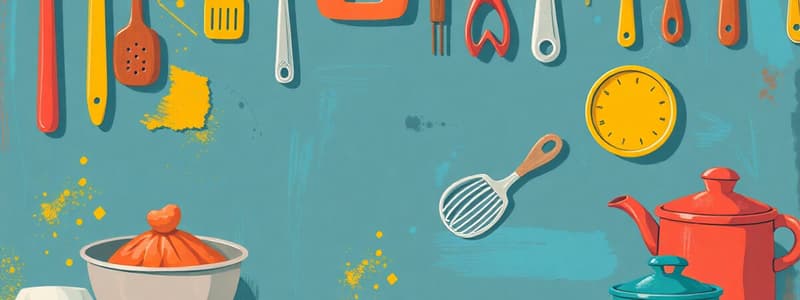Podcast
Questions and Answers
Which knife is specifically designed for slicing roasts and thick cuts of meat?
Which knife is specifically designed for slicing roasts and thick cuts of meat?
- Roast beef slicer (correct)
- Citrus knife
- French knife
- Butcher knife
What type of grind do heavy knives typically have?
What type of grind do heavy knives typically have?
- Razor grind
- Serrated grind
- Hollow grind
- Flat grind or saber grind (correct)
Which knife would be the most appropriate for coring and peeling fruits and vegetables?
Which knife would be the most appropriate for coring and peeling fruits and vegetables?
- Citrus knife
- Paring knife (correct)
- Vegetable peeler
- French knife
What is the primary purpose of a vegetable peeler?
What is the primary purpose of a vegetable peeler?
What category of tools does a mixer fall under?
What category of tools does a mixer fall under?
What is the primary function of a two-tine fork?
What is the primary function of a two-tine fork?
Which material is preferred for making wooden spoons used in cooking?
Which material is preferred for making wooden spoons used in cooking?
Which type of measuring tool is typically used to measure small quantities of both dry and liquid ingredients?
Which type of measuring tool is typically used to measure small quantities of both dry and liquid ingredients?
What is a common material for measuring cups and spoons that are used for dry ingredients?
What is a common material for measuring cups and spoons that are used for dry ingredients?
Which cooking utensil is primarily used for spreading frostings and sandwich fillings?
Which cooking utensil is primarily used for spreading frostings and sandwich fillings?
What is the primary function of holloware in food service establishments?
What is the primary function of holloware in food service establishments?
Which of the following items is considered to be part of holloware?
Which of the following items is considered to be part of holloware?
What type of material is commonly used to create holloware?
What type of material is commonly used to create holloware?
Which of the following is NOT a characteristic of holloware?
Which of the following is NOT a characteristic of holloware?
What is likely to be a special occasion where holloware is utilized?
What is likely to be a special occasion where holloware is utilized?
Flashcards
Seafood Serving Tools
Seafood Serving Tools
A utensil specifically designed for cleaning and preparing seafood, often with features for removing shells.
Spatula
Spatula
A flat, flexible tool used to level ingredients, spread frosting, and fill sandwiches.
Two-tine Fork
Two-tine Fork
A fork with two tines used to hold meat while slicing or turning it during cooking, usually made from heat-resistant stainless steel.
Wooden Spoon
Wooden Spoon
Signup and view all the flashcards
Measuring Spoons
Measuring Spoons
Signup and view all the flashcards
Holloware
Holloware
Signup and view all the flashcards
Holloware Examples
Holloware Examples
Signup and view all the flashcards
Platter
Platter
Signup and view all the flashcards
Hot Food Cover
Hot Food Cover
Signup and view all the flashcards
Butter Pat
Butter Pat
Signup and view all the flashcards
Butcher Knife
Butcher Knife
Signup and view all the flashcards
French Knife
French Knife
Signup and view all the flashcards
Roast Beef Slicer
Roast Beef Slicer
Signup and view all the flashcards
Kitchen Knife
Kitchen Knife
Signup and view all the flashcards
Citrus Knife
Citrus Knife
Signup and view all the flashcards
Study Notes
Lesson Exemplar for TLE Grade 7, Quarter 3, Lesson 5
- This lesson exemplar is for teachers implementing the MATATAG K to 10 Curriculum in the 2024-2025 school year
- The material is for teacher use only and unauthorized reproduction or distribution is prohibited
- Borrowed content is owned by their respective copyright holders
- The document outlines the curriculum content, standards, and lesson competencies for TLE Grade 7, Quarter 3, Lesson 5
- The lesson focuses on food preparation and service tools and equipment
- Learners will identify common tools and equipment used in the food preparation and service industry (industry standards)
- Learners will demonstrate proper maintenance of food preparation and service tools and equipment
- The importance of acquiring knowledge and skills on the correct usage and maintenance of these tools for long-term use
- The lesson is specifically related to SDG 3 (good health and well-being) and SDG 12 (responsible consumption and production)
- The lesson is integrated with related curriculum content and learning resources
Learning Resources
- The lesson exemplar includes teacher-made modules, articles from Kidspot, and websites for cooking terms, weights and measures conversions, and rules of thumb
- Learning resources are included to assist in delivering the curriculum content, standards, and lesson competencies
- The Learning Resources section lists various websites and articles for further information (e.g., websites about cooking, weights, and measurement conversions)
Teaching and Learning Procedure (Day 1)
- Students review previous lesson on HACCP principles
- Students discuss any clarifications concerning the lesson
- Students identify kitchen, tools, and equipment from provided photos/images
- Students explain functions of tools and equipment
- Importance of correct use and maintenance of food preparation tools for sustainability in the food industry
Teaching and Learning Procedure (Day 2)
- Students analyze pictures of various table set-up arrangements
- Students discuss food service tools, utensils, and equipment commonly used in different food service establishments/settings
- Focus on understanding different types of tableware (e.g., plates, cups, glasses, spoons, forks, knives, chafing dishes, cutlery) and their features/functions
- Students identify where food service tables are usually set up (hotels, cafeterias, restaurants)
Teaching and Learning Procedure (Day 3)
- Students describe images of food preparation tools, utensils, and equipment to understand their maintenance procedures
- The teacher guides students on the importance of cleaning and sanitizing tools; understanding proper cleaning and sanitizing methods;
- The proper storage of utensils is discussed
- Students learn about different categories of cleaning agents
- Students learn about sanitizing methods (heat, chemicals) focusing on proper sanitizing practices (using appropriate tools and equipment). Proper sanitizing procedures to ensure food safety is emphasized
Additional Notes
- The lesson incorporates activities to reinforce learning (e.g., analysis of photos, identifying tools, discussions, and activities based on the given scenario)
- The lesson is aligned with various learning objectives to improve instructional approaches, and address any feedback
- This is a detailed lesson plan, focused on food preparation and service; including proper maintenance to ensure food safety and proper use; and practical applicability for students, to understand the importance of kitchen/food tool maintenance
- The given document is also a resource to support teachers implementing these tools and procedures
Studying That Suits You
Use AI to generate personalized quizzes and flashcards to suit your learning preferences.




